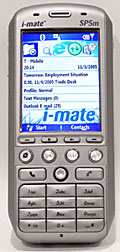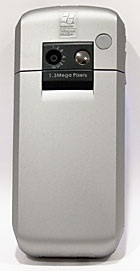
|
|||||||||||||||
The SP5m has jettisoned the asymmetric joystick/paddle of the SP3 which many users found irritating; it was perfect in an up/down mode, not bad in left/right but failed when pressed fully to do an 'OK', often creating a left or right just before the 'Press'… Let me tell you, if I had a cent for each time that went wrong I'd have, well, about enough for a Big Mac but ok it was annoying! We now have a regular joystick; up/down/left/right all equal and the press is just press - nice. Hot keys for Internet explorer and controls for the media player are nice but I'd have liked to see a short-cut to Calendar. On the top sits the multi-function Power button and the IR sensor - just IRDA not commercial. On the right we have a single button for Camera and on the left volume up/down,'Comm Manger' and a place to attach a lanyard. The base of the unit provides connections for earpiece/headphones and a USB data and power connector. On the back is the 1.3M pixel camera with self-portrait mirror… How vain.
The big visual change is the display; it's 2.2" diagonal as before but now has a resolution of 240 x 320 - wow! The pixel density is so high that clear-type is pretty much pointless. Characters on screen are beautifully formed from curves and colors rather than the little pixel bricks of the previous 176 x 220 SP3. It's bright too which allows for a lower than full setting and so less power is consumed. Also on the power front, they've retained the photo-sensor that only lights the keyboard when it's really dark. It looks very nice on the SP5M as the round buttons each feature a round illuminated border. Below the screen are the Windows required soft-keys with hard 'Home' and 'Back' buttons. The numeric pad is tight but workable and the buttons yield a very positive feedback. The OS includes multi-language T9 input that has now added the ability to manage the dictionary. This is a great feature as you can grow and maintain the dictionary dynamically as you go yet still manage entries that it adds in error. Examples are when you accidentally teach it a miss-spelling! Overall performance of the word search function seems on a par with the last version. I've seen teenagers T9'ing at speeds I'd have trouble with on a regular keyboard. That said, I'm not a teenager and can't go that fast but, for quick, short emails and sms messages it's ok. Phone Features and Reception The radio has been overhauled; it's now a Quad-Band GSM solution with EDGE support but the big wow is that they've added, for the first time in a SmartPhone; WiFi 802.11b wireless. The phone radio is fine; it's the equal of any typical mobile phone pulling in and holding on to a signal. Features include multi-party calling, conference, waiting, hold, lock, SMS messaging with concatenation of messages up to 640 characters in length and alternative line service which, though not offered by T-Mobile yet allows you to have two numbers on the same phone. Last night I was able to juggle a dozen calls in and out and managed to set up a conference call on the mobile with ease; such is the usability of the phone. The old SP3i suffered some issues with the radio coming out of 'Flight mode' with the radio still off. I have experienced one incident of the phone reporting a bad SIM that shut down the radio and a couple of times the phone has taken its time to recover a signal after going through a weak spot. Such are the vagaries of cellular reception that I'll assume these to be addressed in a ROM update as they have been before. The EDGE data feature gives a steady 100+ Kbps data transfer on the T-Mobile network that I'm testing on so that's GSM 2.5G working well. Audio quality is good; it's clear and has a good dynamic range, it is especially evident in-car where every scrap of clarity is needed to help reduce fatigue. The internal speaker is solid and loud enough in normal operation. Speaker phone mode works well but only in a quite room with a few people around a table; not bad for a mobile phone though! Phone features include a vibrate option that's included in a very flexible choice of ring and notification options; you can even use video as a ring-tone. Horsepower and Performance The CPU is a 195Mhz Texas Instruments OMAP 850 as reported by the system status utility. It's ARM compatibly and sprightly in operation. With each speed increase TI seem to become more power efficient too and that reflects in the talk time of 5 hours - up one from the SP3. The phone now runs Windows Mobile 5, this is based upon Windows CE 5 and calls for a different memory model that before. If you've just figured out how Pocket PC and SmartPhone do that whole RAM/ROM overlay thing… un-learn it; in CE 5 you have ROM (think hard disk) for programs and RAM (think, er, RAM) for programs to run in; just like a PC. Programs and data sits on the hard drive (ROM) and gets loaded into RAM when it runs. The result is that application startup takes a little longer than before but the more efficient processor levels that out, once running the apps are noticeably snappier in action, so too is the primary role of the SmartPhone; being a phone. The SP3 running Microsoft Windows SmartPhone 2003 realized that it had a duty to answer and place calls over and above all other tasks; and this it did quite well, much better than Pocket PC Phone Edition does. This latest version of the operating system re-enforces that sense of duty despite having the Smart part of the phone do a little extra work as that takes place; Photo ID being a good example. In the SP3 the Photo ID application was a bundled third-party application that whilst functional never felt part of the picture (no pun intended). Photo ID on calls is now integrated and despite sending the processor to the ID database with each call placed or received the performance remains snappy and responsive. This is a great thing because in a recent survey one of the features most requested by phone users was that the phone be a phone first. For more information on Windows Mobile 5 on the Pocket PC, see the MobileTechReview editorial. For SmartPhone the differences are much more subtle that before, the difference between Windows Mobile 2003 and the Smartphone 2003 OS were significant, now, much more familiar. It's true that the SmartPhone version has been tweaked to be usable with keyboard alone but it's more a tweak than a re-write of the UI. Memory is 64Mb RAM and 64Mb FLASH ROM. At rest there is 17Mb of RAM available, 7MB Flash ROM. With email, web, camera, contacts, Windows Media, Call History and file manager running, available RAM is still 16Mb. Expansion slots One feature carried over from the previous model was the unusual location for the mini-SD expansion slot; it's under the battery, I don't mean south of the battery I mean, you have to take out the battery to change it. Think of it as a hard drive; buy the biggest you need / can afford, install it and forget it. In my case I have a 1Gb Sandisk mini-SD card that fits a few maps for my GPS software, some application data for my RSS news reader and an afternoons worth of music. I'd like to be able to swap the card more easily, like you can with every other Phone / PDA / Anything that uses removable memory. It's an odd choice of location but oddly, after saying all of that, it's never been a huge problem, in fact the only time I've ever changed cards on my SP3 was when I was watching movies on it whilst in flight and then I didn't have the phone part on so was not a any risk of missing calls. Display, Gaming and Multimedia The display and the new joystick lend the unit to a bit of gaming; not a strong point for me, I still haven't finished the daft 'Jawbreaker' game that comes with it! What does work is my favorite video player betaplayer which has recently changed its name to TCPMP. Watching some content that I created for Smartphone at just 150Kbps revels the new display to be much more detailed and hence deserving of higher quality. At 250-350Kbps MP4 with AAC or MP3 audio TCPMP played back content in excellent quality for a fantastic 6 hours on a charge - That's NY to London! It's true that you don't have a phone after that so carry a spare battery. Note that 6 hours is with the radios turned off. The 2.2" display at 240 x 320 resolution is both bright and detailed, the contrast ratio is high yet the power consumption from the backlight is low. Sound quality is good, plenty of dynamic range and good clarity. There is a switch-on thump when the audio electronics are activated and deactivate but one thing that did show up was a balance problem; the right-hand channel is clearly louder than the left resulting in a shift in balance that is especially evident on vocal tracks. I suspect that the problem can be resolved but as a Music phone this is a bit of a big issue. I tried a couple of units to make sure that I didn't have a faulty unit but each had the same problem. I noticed the same problem with the i-mate SP5 but the QTEK 8310 does not have this problem. One feature of owning an i-mate product is the included access to Club i-mate. It's an exclusive club with full access only granted to those with the right IMEI number - the globally unique serial number of the phone. On Club i-mate you can find exclusive downloads and some mobile optimized video content that's quite fun to watch - members pay less. Overall, I think that video playback on the SP5m is good, good enough to make a second video player purchase redundant. The screen is small so you'll need to consider that for yourself. Camera The SP5 is equipped with a 1.3M pixel camera and self-portrait mirror but no flash. The native resolution is 1280 x 1024, quality is on a par with other phone cameras; good for party snaps. The version of the phone that I am using has not been customized by a carrier so I had to carry out a great deal of configuration to get the MMS email function working; once there photos can be quickly snapped and sent to friends, relatives and insurance companies. Like most HTC cameras, the SP5m's shows color fringing and blown out lightlights, and it can't handle night shots well. That said, it's better than many of Motorola's current cameras, but much worse than Nokia and LG's recent offerings. Video performance was on a par with its HTC peers; a few frames a second at H.263 encoding. A gimmick only I'm afraid. Sample Photos:
Bluetooth Bluetooth support is very much improved in WM5 and now works with a much broader range of devices. Of particular note is its support for Human Interface Devices; Keyboards and Mice. I was very pleased when I paired my Dell (Think Outside) BT keyboard to the phone and it worked instantly! More interesting though is that the menu's automatically changed to the typical underscored entries and dropped the numbers by the menus for letters and it won't go back! For those new to Smartphone, when you press 'Menu' the menu items have a number by the side to allow you to quickly jump to that item… They've now gone, even a re-boot won't restore my menus! - Pass me the registry editor. The phone also paired and recognized the Think Outside BT mouse, it even showed a mouse icon by the entry but unfortunately, it couldn't figure out what to do with it. This shows that the code base differences between Pocket PC and SmartPhone have indeed narrowed somewhat. So why get so excited about attaching a keyboard to your phone? Well, it's all about protecting your investment. I still want a device that has a big screen, keyboard but only weights 80g and fits in my pocket; I'm not going to get that but if I saddle myself with a large Pocke tPC Phone I'm going to end up carrying a large device with me all the time for functionality that I'll use less often. By allowing an external keyboard on a phone I can choose to carry the keyboard when I anticipate needing it, or, not buy the keyboard right away. In use, the keyboard and phone combo allow full speed typing with an admittedly small but very clear screen. Pairing with a number of headsets, the Motorola HS850, the BlueSpoon AX2 and the Mini Cooper worked well. Each offers excellent call volume and clarity within the limitations of the device. WiFi The incorporation of Wi-Fi in an EDGE device is interesting. I thought it would be a little redundant but it's clear that the performance of the Wi-Fi interface is better than EDGE; Web pages draw more quickly and Active-Sync completes in a shorter time. The effect on battery life is marked; the radio defaults have it switch off after just a few minutes of inactivity; it restores when you begin to use the system again but it does not seem to start up to grab email, instead preferring the GPRS connection. The Wifi solution is intended to permit dynamic switch for data between Wi-FI, EDGE and regular GPRS as conditions change. T-Mobile Hotspot, Panera free wifi, home. The integrated 'Comm Manger' software is launched from its own dedicated button on the side and allows switch on and off of the various radios. It can call for an 'Active Sync' there too; useful if you're hitting a wi-fi hotspot and want to activate wifi, sync and go. Security on Wi-Fi is good, it supports WEP, WPA, and LEAP and can be configured to remember your favorite. spots. One nice option is the ability to turn off the "Hey I've found a new hotspot; want to connect?" nag screen. When I want Wi-Fi, I'll go and find it thanks. I'll be interested to see if they produce a SmartPhone version of the Skype application. Battery Life The SP5m features a removable 1150mAh battery behind a much improved battery door. I can't say that there'll be an extended option, but if so it'd need a new back to accommodate it. Battery life is a claimed 5 hours. I suspect that'd be a stretch. With just 20 mins of calls and some browsing plus hourly active-sync I'm down to 60% battery on the meter. I'm not worried as that appears equal to my SP3 and in reality it pans out to be a couple of days usage but 5 hours would I think have to be five hours straight talking in a good reception area with the display off. If you want to deplete your battery as fast as possible though, switch on Wi-fi and take a drive through a "Wi-Fi" neighborhood; I managed to consume 20% in 20 Minutes… If you do the math you can see how quickly you could run the battery flat! Software The Smartphone is a phone first then a PDA so the list is shorter than Pocket PC. There's no Word/Excel/PowerPoint but there is Email, Calendar, Contacts and Tasks plus Windows Media Player, Internet Explorer and Pocket MSN. i-mate add the HTC applications for Camera and Video Camera though the output is viewed on Microsoft's integrated Pictures and Videos app. System tools include an HTC File Manager but no Registry Editor. The Windows Mobile 5.0 Microsoft applications have all been enhanced across the board. All have been given new interface tweaks to improve appearance and functionality. It's 50% window dressing and 50% evolution. Good examples are the inclusion of photo's in the contacts which are supported right through to Microsoft Outlook. The platform includes a JAVA virtual machine with a dedicated download manager. Anti-Virus: The SP5m ships with an Anti-virus client from Computer Associates. Innocuous in use, it downloads definitions automatically and intercepts file request scanning email and files on open. It will, no doubt be itself the target of a virus such is the hacking community but I suspect it will hold up being a long time fan of CA's desktop AV solutions. For those who are familiar with SmartPhone and with Windows 95 and above, the Start Menu was a great idea; press start and up comes a list of all of your programs and useful places to go. Microsoft has replaced it with something like Windows 3.1 Program Manager. It's a screen full of icons that you must navigate to using the joystick. It's not awful but unfamiliar. I think that it was re-introduced as a more familiar choice for Motorola and Sony Ericsson users. Apparently it can be returned to normal through a registry tweak at "HKCU\Software\Microsoft\Shell\StartMenu\GridView = 0"… now you know why I want the registry editor. ActiveSync is the Microsoft application used to link the phone to the desktop. Physically it's a USB connection. From the software you can browse your phone as a disk device and set up and configure synchronization. Sync. of email, tasks, favorites, calendar and contacts can be completed with the included Outlook Client or your installed Microsoft Office. Email, Calendar and Contacts can be synchronized with a Microsoft Exchange server over the air. Note that I couldn't get Task sync working but need to spend more time on that problem. You can't underestimate the value of synchronization, especially over-the-air; it's great to get a new contact number, type it into your PC then, call it on your phone. Read emails on your phone, reply and forward; great stuff. The version of Active-Sync that ships with Widows Mobile 5 devices is now 4.0. Visually it's similar but helps separate server sync with local sync. Third-party software for the Microsoft Smartphone abounds and there are version optimized for the new OS features. It's unlikely that an investment in Microsoft Smartphone would leave you wanting for any application. Conclusion This review has been a short introduction to the new i-mate SP5m. It's very clearly a worthy evolution of the breed. It's faster, smarter and more connected. There'll need to be a ROM update for that keyboard problem and perhaps the SIM issue. The audio problem is odd given the phones slant towards music playback, I await i-mates comments. But, with its issues it is still such a Swiss Army Knife of phones that I'm prepared to rough it. The last SP3 started in this way and after a few updates ended as being my favorite phone, it became like an essential tool that never went blunt. The SP5m starts just shy of that but will no doubt eclipse its forbear. For that start I must give it 4½ out of 5. Pro: A really good phone, great screen, fast access to your corporate info. Cons: I'll never type as fast on T9 as on a thumb-board. Active-Sync 4.0 not as compatible with apps and the audio problem is a show-stopper for the keen audiophile. Price: $499 Web Site: www.i-mate.com Where to Buy: Our review unit came from Mad Monkey Boy's Gadgets
| |||||||||||||||




